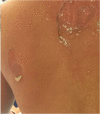Management of Infectious Emergencies for the Inpatient Dermatologist
- PMID: 34642610
- PMCID: PMC8493951
- DOI: 10.1007/s13671-021-00334-5
Management of Infectious Emergencies for the Inpatient Dermatologist
Abstract
Purpose of review: There are various dermatologic emergencies stemming from bacterial, viral, and fungal etiologies that can present in the inpatient setting. This review summarizes the pathogenesis and diagnosis of infections with cutaneous involvement and highlights new therapies.
Recent findings: Clindamycin inhibits toxin formation and can be used as an adjunct therapy for the staphylococcal scalded syndrome. Isavuconazole therapy for mucormycosis infection is a less toxic alternative to amphotericin B.
Summary: Diagnosis of these infections is primarily guided by high clinical suspicion and early recognition can prevent dangerous sequelae. Treatment mainstays have been well-established, but there are adjunctive therapies that may potentially benefit the patient.
Keywords: Cutaneous manifestations of infection; Dermatologic emergencies; Dermatologic infection; Skin infection.
© The Author(s), under exclusive licence to Springer Science+Business Media, LLC, part of Springer Nature 2021.
Figures



Similar articles
-
Neonatal Skin Emergencies.Pediatr Ann. 2019 Jan 1;48(1):e36-e42. doi: 10.3928/19382359-20181210-03. Pediatr Ann. 2019. PMID: 30653641 Review.
-
Staphylococcal scalded skin syndrome: diagnosis and management in children and adults.J Eur Acad Dermatol Venereol. 2014 Nov;28(11):1418-23. doi: 10.1111/jdv.12541. Epub 2014 May 20. J Eur Acad Dermatol Venereol. 2014. PMID: 24841497 Review.
-
Breaking the Mold: A Review of Mucormycosis and Current Pharmacological Treatment Options.Ann Pharmacother. 2016 Sep;50(9):747-57. doi: 10.1177/1060028016655425. Epub 2016 Jun 15. Ann Pharmacother. 2016. PMID: 27307416 Review.
-
Dermatologic Urgencies and Emergencies: What Every Pathologist Should Know.Arch Pathol Lab Med. 2019 Aug;143(8):919-942. doi: 10.5858/arpa.2018-0239-RA. Epub 2019 Feb 20. Arch Pathol Lab Med. 2019. PMID: 30785787 Review.
-
Tatami Mats: A Source of Pitted Keratolysis in a Martial Arts Athlete?Acta Dermatovenerol Croat. 2018 Apr;26(1):68-70. Acta Dermatovenerol Croat. 2018. PMID: 29782305 Review.
Cited by
-
Assessing the use of antibiotics in pediatric patients hospitalized for varicella.Ital J Pediatr. 2022 Dec 12;48(1):196. doi: 10.1186/s13052-022-01393-5. Ital J Pediatr. 2022. PMID: 36503563 Free PMC article.
-
Analysis of Types of Skin Lesions and Diseases in Everyday Infectious Disease Practice-How Experienced Are We?Life (Basel). 2022 Jun 29;12(7):978. doi: 10.3390/life12070978. Life (Basel). 2022. PMID: 35888068 Free PMC article.
-
Toxic Shock Syndrome Toxin-1 (TSST-1) in Staphylococcus aureus: Prevalence, Molecular Mechanisms, and Public Health Implications.Toxins (Basel). 2025 Jun 24;17(7):323. doi: 10.3390/toxins17070323. Toxins (Basel). 2025. PMID: 40711134 Free PMC article. Review.
References
Publication types
LinkOut - more resources
Full Text Sources
Research Materials
